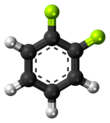| |||
| Names | |||
|---|---|---|---|
| Preferred IUPAC name
1,2-Difluorobenzene | |||
| Other names
o-Difluorobenzene
ortho-Difluorobenzene | |||
| Identifiers | |||
3D model (JSmol)
|
|||
| ChEBI | |||
| ChemSpider | |||
| ECHA InfoCard | 100.006.074 | ||
PubChem CID
|
|||
| UNII | |||
CompTox Dashboard (EPA)
|
|||
| |||
| |||
| Properties | |||
| C6H4F2 | |||
| Molar mass | 114.093 g/mol | ||
| Appearance | colorless liquid | ||
| Density | 1.1599 g/cm3 | ||
| Melting point | −34 °C (−29 °F; 239 K) | ||
| Boiling point | 92 °C (198 °F; 365 K) | ||
| (insoluble) 1.14 g/L | |||
| Related compounds | |||
Related compounds
|
1,2-Dichlorobenzene | ||
Except where otherwise noted, data are given for materials in their standard state (at 25 °C [77 °F], 100 kPa).
| |||
1,2-Difluorobenzene, also known as DFB, is an aromatic compound with formula C6H4F2. This colorless flammable liquid is a solvent used in the electrochemical studies of transition metal complexes. Compared to most conventional halogenated aliphatic and aromatic solvents, it possesses an exceptionally high dielectric constant (ε0 = 13.8 at 300 K). Thus, it can be a suitable solvent for cationic, and/or highly electrophilic organometallic complexes.[2]
- ^ David R. Lide, ed., CRC Handbook of Chemistry and Physics, 89th Edition (Internet Version 2009), CRC Press/Taylor and Francis, Boca Raton, FL.
- ^ Pike, Sebastian D.; Crimmin, Mark R.; Chaplin, Adrian B. (2017). "Organometallic chemistry using partially fluorinated benzenes" (PDF). Chemical Communications. 53 (26): 3615–3633. doi:10.1039/C6CC09575E. PMID 28304406.

